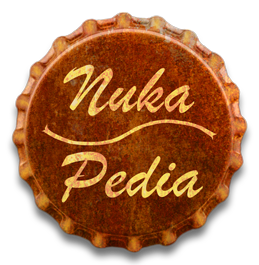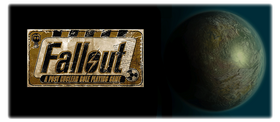The Fallout world exists in an alternate timeline that completely diverged from the real-world timeline after World War II. From this split until the Great War in 2077, a stylized representation of 1950s American culture (with more advanced technology) dominated the Fallout world. The science-fiction anthology Worlds of Tomorrow, released during the Golden Age of Science Fiction in the 1950s, heavily influenced this representation.
Overview
Although events in the Fallout universe and the real world diverge around the mid-1940s, the defining moment of the Fallout universe was the Great War of 2077. Dwindling petroleum reserves led to a series of regional wars for resource control, and economies began to fold as nations were left without this vital lifeline. Alternative sources of energy were explored, leading to the maturation of nuclear fission technology, as well as various innovations in solar and hydroelectric power, and even nuclear fusion, but none of these were sufficient to serve the global population's ever growing needs.
With the available reserves of crude oil in the world constantly diminishing, the communist government of the People's Republic of China declared war on the United States, invading Alaska for the few remaining sources of oil there. The Sino-American War raged for eleven years, eventually culminating in a nuclear exchange between China and the United States. Both nations had built up huge stockpiles of nuclear weapons, and the mutual attack drew in enemies and allies from all around the world, igniting every hatred forged throughout the century-long cold war. Although the conflict lasted only two hours, the destruction it brought was staggering and complete. More energy was released in the early moments of the exchange than in all previous global conflicts combined. This global nuclear conflict came to be known as the "Great War".
The world that remained was harsh and unforgiving. Ninety years after the Great War, humanity struggled to survive. On the surface, bandits and organized gangs fought over the crumbling remains of once-great cities, and mutants prowled the irradiated wastes. Underground, a fortunate few enjoyed the relative safety and comfort of the Vaults, designed before the war, with the proclaimed purpose of protecting residents and their descendants from the nuclear annihilation. Some planned to keep the world out, others sought to connect with and repopulate the outside. Wherever humanity survived, it was under constant threat by ravenous mutants, rogue machines, vicious raiders, and all manner of hostile mutant creatures.
Most of the events of the series took place in the United States. The first two games, Fallout and Fallout 2, were set in New California, the remains of the West Coast, in which the Master and the Enclave were the region's main threats. The third game, Fallout Tactics, took place in the Midwest, between the city of Chicago and Cheyenne Mountain in Colorado. The fourth game, Fallout: Brotherhood of Steel, took place in northern Texas in the town of Carbon and the ghoul city of Los. The fifth game, Fallout 3, was set on the East Coast of the United States in an area called the Capital Wasteland; this included the remains of Washington, D.C., parts of Virginia, Pittsburgh and Maryland. The sixth game, Fallout: New Vegas, took place in the Mojave Wasteland which included parts of California, Utah, Arizona, and Nevada. Fallout 4 is set in the Boston, Massachusetts metro area, including notable landmarks in the City of Boston and the City of Cambridge as part of The Commonwealth. Fallout 76 takes place in Appalachia, formerly the state of West Virginia.
Major events
Before the Great War
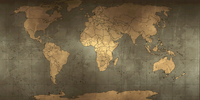
World map
For most of human history, the Fallout universe and the real world shared a common timeline. Fallout draws its music from the 1940s and 50s in addition to the decades afterwards. However, in 1945, significant political and technological differences in the Fallout timeline set it on a different course. In 1947, the circumstances involving the invention of the transistor are muddled and miniaturization of electronics was neglected. Some time before 1969, in an attempt to mitigate the influence of Communism, the United States adopted a system of 13 Commonwealths. In 1970, China failed to adopt any free market reforms and ended up retaining a political and economic structure similar to what it had under Communist Party Chairman Mao Zedong beginning in 1949. In 1991, the USSR did not collapse.
No major international conflicts took place until the middle of the twenty-first century. In 2052, the oil-rich Middle East nations raised oil prices causing the economic collapse of many smaller countries. The European Commonwealth (analogous to the real-world European Union), similarly dependent on oil imports from the Middle East, began the Resource Wars by responding with military force. The United Nations, weakened by its inability to prevent the conflict, attempted to intervene. Many of its member nations responded by withdrawing, with the UN disbanding that year.
The United States, supplied with oil from Texas and Mexico, escaped any direct impact from the Resource Wars. However, the U.S. would soon have significant problems of its own. In 2052, the Texas oil fields ran dry, making the country severely vulnerable to energy shortages. In 2053, the New Plague began to ravage the U.S. population, causing an estimated 200,000 deaths and prompting the government to close the country's international borders. Nuclear fears gripped the country when, in the same year, Tel Aviv was destroyed by a terrorist nuclear weapon and, in the following year, warring nations exchange nuclear weapon strikes in the Middle East. In response, the Americans began Project Safehouse: a series of underground Vaults designed to survive nuclear war or an epidemic.
In 2059, oil resources grew increasingly scarce. To secure the Alaskan oil fields, the United States ramped up its military presence in that state, creating the Anchorage Front Line. Relations with Canada grew increasingly strained as the Americans pressed to have their military units stationed on Canadian soil to protect the Alaskan pipeline.
In 2060, the Middle Eastern oil fields ran dry, not only ending the Resource Wars in Europe, but the European Commonwealth as well. Without a common enemy, the European nations fought among each other for the remaining resources. Fossil fuels became too expensive to use in automobiles and alternatives began to appear in the market. Advances in nuclear technology paved the way for nuclear fusion to replace traditional fossil fuel-based combustion engines in automobiles and other vehicles.
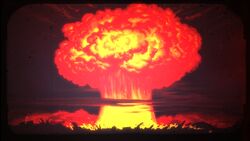
Great War
In 2066, the Resource Wars shifted to the other side of the globe. China, their oil reserves exhausted and their economy near collapse, invaded Alaska. America strong-armed Canada into allowing troops and planes to move across Canadian territory on their way to the Alaskan theater. Relations between the neighboring countries continued to worsen as the Americans help themselves to Canadian resources, ignoring Canadian protests. Many Americans began referring to Canada as "Little America," worsening relations.
In 2072, the Sino-American War raged on. While American power armor proved effective in localized conflicts, it fails to completely dislodge Chinese forces. The U.S. continued to demand more resources from Canada. When an attempt was made to sabotage the oil pipeline, the Americans (officially) began to annex Canada. In 2076, the annexation is complete. Also that year, Americans deployed the T-51b power armor to the Chinese mainland. The suits were highly effective and American troops cut a swath through Chinese territory.
In early 2077, the Americans reclaimed Alaska, but no armistice was signed. Those in positions to foresee the nuclear conflagration make final preparations: Robert House puts himself in stasis; the President and the Enclave retreat to the Poseidon oil rig. The American public, having been exposed to too many false alarms, largely ignored the warning sirens when the bombs begin to fall. Many Vaults are underpopulated as their doors shut.
In the early hours of October 23, 2077, the world—as everyone knew it—ended. Missiles and bombs rained from the sky, engulfing the world in flames, in an event that would become known as the Great War. Cities and nations fell, and humanity descended into a nuclear Dark Age. Many believed it was the end of human civilization, but instead it was simply the beginning of a new and bloody chapter.
The Post-War world
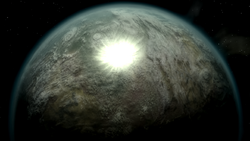
Part of the Earth after the Great War
The collapse of global civilization made it impossible to ascertain the full extent of the damage brought by the nuclear bombs. As viewed from orbit, there were clear signs of a global catastrophe, and much of the world's oceans were tinted green by radiation. The Great War's enduring legacy was the radiation that spread in its wake. Many of the plants and animals that survived the nuclear fire were killed by the irradiated rain that fell a week later. Of those that survived, many were mutated by 2080.
The American mainland was reduced to wasteland. Most major American cities, with a few exceptions such as Pittsburgh and Las Vegas, were razed by the bombs. Even the surviving cities were reduced to hellish ruin as society rapidly disintegrated. Although the Vaults were never intended to preserve the entire American population, enough of their residents and technology survived for them to jumpstart civilization when they opened.
While most areas were bombed, some areas like Appalachia, New Vegas, and Zion Canyon were left mostly intact compared to other areas in the rest of the known world.
Some locations had odd effects after the bombs fell such as Big MT having no mountain top, the Sierra Madre being covered in a strange mist, and The Island being covered in a radioactive fog.
New California benefited the most from these early openings. In 2083, Vault 12 established Necropolis in Bakersfield. Eight years later, Vault 8 established Vault City in Western Nevada, and the following year, the LA Vault established the Boneyard in Los Angeles. Fifty years later, in 2142, former residents of Vault 15 established Shady Sands northwest of Necropolis.
The Mojave Wasteland was another incubator of civilization. This was due in no small part to Robert House's preparations; his secret missile defense systems ensured that Las Vegas and the surrounding desert were hit by fewer bombs than anywhere else in the region, and as time passed, the city was rebuilt through the combined efforts of House, the local tribals, and residents of Vault 21. Its infrastructure was so far advanced that, by 2281, it was—according to House—within a century of being able to launch a colonization spaceship.
In the East, the Capital Wasteland was also left surprisingly intact. Although unable to compete with the more advanced societies of the West, it was nonetheless able to support a local radio station, caravan routes and a large-scale water purification plant.
Similarly, The Commonwealth of Massachusetts and Boston were left relatively unharmed, being struck by only a single, high-yield nuclear weapon in an area that came to be known as the Glowing Sea. Like the Capital Wasteland, it too supported caravan infrastructure, regional radio broadcasts, and other such amenities.
Appalachia was left largely unaffected by the bombs, aside from mutations and radiation, most areas look very similar to their pre-war counterparts.
As these regions rose from the ashes, so too did new societies. The New California Republic was established in 2186 and would control all of New California a century later. The Brotherhood of Steel was founded days after the Great War and would become a technological powerhouse by 2150. The Enclave—descendants of the United States government and military-industrial complex—made its presence felt in New California in 2237 and then in the Capital Wasteland in 2277. The Rome-obsessed slavers of Caesar's Legion arose in 2247, forged from the conquest of 87 tribes, and would control most if not all of Arizona and New Mexico, along with some holdings in eastern Utah and parts of southern Colorado.
While very little is known of the world beyond the former United States, things seem to be significantly worse in Great Britain and Ireland than in North America, as inhabitants of the Isles often emigrate to the American wastelands in search of fortune, opportunity, and a better life.
Creatures
The distinctive creatures in the Fallout world arose after the Great War and were the result of exposure to radiation or the Forced Evolutionary Virus.
Radiation led to the spontaneous rise of many new species three years after the bombs fell. The new species were larger, hardier and more dangerous than the animals and insects from which they mutated. Radscorpions, giant ants, and brahmin descended from scorpions, household ants and cows, respectively.
A ghoul
Heavy exposure of radiation mutated some humans, who possessed a particular genetic trait, into ghouls. Although their decaying skin gave them a frightening, almost inhuman appearance, they generally retained their mental faculties: their ability to reason and communicate were left intact. Ironically, despite their physical decay, they had heightened senses and longer lifespans.
Varying degrees of exposure gave rise to diversity within the ghoul community. Ghouls exposed to prolonged radiation poisoning lost their intelligence and mutated into feral ghouls. Longer periods of radiation exposure resulted in further degeneration into Glowing ones—ghouls with heightened physical capabilities who literally glow in the dark.
The remainder of mutations were caused by the Forced Evolutionary Virus (FEV). Its origins lie in the years preceding the Sino-American War. In an effort to defend against a Chinese biological attack, defense contractor West Tek initiated the Pan-Immunity Virion Project. The goal was simply to make the human immune system strong enough to resist any pathogen, natural or engineered. Some of the side effects, discovered during testing, were increased size and strength. The U.S. Army seized the project in an effort to create a super soldier. They moved the project to the Mariposa Military Base. They also sent a large sample to Vault 87 on the East Coast as part of the Vault Experiment.

The Master
Following the Great War, Mariposa was abandoned—the surviving leadership having left to form the Brotherhood of Steel. After laying dormant for 30 years, the base was rediscovered by Richard Moreau, an exile from Vault 8. After realizing that the FEV could be used to create super mutants, he attempted to raise an army but was defeated by the Vault Dweller.
Despite the destruction of Mariposa base, a sample of its FEV was claimed by the Enclave. Using slave labor kidnapped from nearby Redding, the Enclave excavated Mariposa. Those slaves inadvertently exposed to the FEV mutated into a new batch of super mutants.
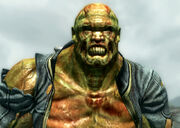
Fawkes, an intelligent super mutant
On the East Coast, the FEV sent to Vault 87 was used to create that area's own variety of super mutants. Shelton Delacroix, a Vault 87 security officer, was forcibly exposed to and mutated by it. While the mutation process took away much of his intelligence, he was, astoundingly, able to reclaim much of it by studying the Vault's database. The FEV also made it into the hands Weston Lesko who inadvertently, but tragically, used it to mutate giant ants into fire ants.
Locations
The United States, post-war.
The West
Western part of the former United States
The first part of The West is known as the "Core Region," mostly made up of New California. More specifically, New California stretches from Baja in the south to Klamath in the north. It covers most of the West Coast of the United States, including California and parts of Oregon and Nevada. It is a largely inhospitable region, which is why most people have chosen to seek refuge in the ruins of the old cities, where they have found (relative) safety in numbers. However, as resources grew more and more scarce, people and creatures came to consolidate into groups of their own kind, so locations are far more homogeneous than one might expect from a world ravaged by mutation.
The ghoul population of New California was mostly clustered around old Bakersfield (Necropolis), but were scattered after an attack by the Master's Army. Most of the surviving ghouls eventually found a home in Gecko or Broken Hills along with humans and super mutants, both far to the northeast of their former home.
Super mutants were plentiful in the Mariposa area from 2102 to 2162, and they sent patrols as far as to Los Angeles. After the Master's defeat, however, most of them retreated to the east.
Humans are the dominant species of the wasteland, and their main cities in New California are The Hub, Los Angeles Boneyard, NCR, Vault City, New Reno and San Francisco.
As of 2281, most of New California is part of the NCR.
Mojave Wasteland
A crudely drawn map of the Mojave Wasteland
The Mojave Desert is now known as the Mojave Wasteland. The Mojave Wasteland is the second largest desert in North America, and serves as the primary setting of Fallout: New Vegas.
The Mojave occupies a significant portion of southern California, Nevada, and parts of Utah and Arizona.
Before the Great War, Las Vegas was the largest oasis of civilization in the Mojave, and New Vegas seems to maintain that reputation. Seventy-seven atomic warheads were launched at the city and surrounding areas, but due to an intricate system set in place by Mr. House, 59 were force disarmed, nine were blasted out of the sky by a laser-guided missile defense system atop the Lucky 38, and only nine hit the surrounding desert, resulting in the local climate and wildlife being much less radioactive, if not radiation-free, than in other places in the post-atomic United States.
Most denizens attribute the region's survival to the Chinese betting against the House—but the House always wins.
The NCR is the most powerful faction in the area, with New Vegas being on the edge of the Republic's southern borders. Other significant powers are Caesar's Legion, the Great Khans, who—before the NCR came—had a strong grip on the region and a surviving pocket of Mariposa super mutants, called the State of Utobitha, and the Three Families that run casinos in New Vegas. The Brotherhood of Steel also have a small secret base in the area.
East Coast
Eastern part of the former United States
While, strictly speaking, the "East Coast" describes the entire Eastern Seaboard of the continental United States, within the Fallout universe, it chiefly refers to the northeastern U.S. Its major locations were the Capital Wasteland along the coast, The Pitt, the Commonwealth and the Island.
The Capital Wasteland encompassed the ruins of Washington, D.C. and the surrounding wilderness. The city's downtown, though surrounded by rubble and accessible only through its Metro system, was a hub of activity. The Galaxy News Radio building was operational, its signal amplified by dish atop the Washington Monument. A contingent of slavers operates out of the Lincoln Memorial. Brotherhood of Steel paladins, super mutants and Talon Company mercenaries fought to control The Mall. The Museum of History housed a ghoul colony.
Just outside the city, the Brotherhood of Steel had a base in the ruins of the Pentagon. Along the banks of the Potomac River, Project Purity operated out of the Jefferson Memorial.
The wilderness surrounding Washington, D.C. was home to various vaults and settlements. Rivet City was the most successful settlement and was instrumental in delivering Aqua Pura to the area when Project Purity was completed. Vault 87 produced the region's super mutant population. Vault 101 was the home of the Lone Wanderer.
To the immediate south of the Capital Wasteland was the former coastal resort of Point Lookout. To the Wasteland's immediate west was Adams Air Force Base where the Enclave sought to rebase itself after the destruction of their original East Coast base, Raven Rock, by the Lone Wanderer.
The Pitt was the steelyard and surrounding area in the ruins of Pittsburgh. It was infested by Wildmen and trogs until a Brotherhood of Steel detachment led by Paladin Owyn Lyons cleared the area on their way to the Capital Wasteland. They left behind Ishmael Ashur, one of their own, who transformed The Pitt into a slave colony. Just outside were the settlements of Ronto and Monroeville.
The Commonwealth consists of the city of Boston and its surrounding towns, which weren't hit as hard as many of the other cities in the United States, leaving most of the land relatively intact. Several settlements have popped up around the Commonwealth, offering safe haven to the people of the wasteland. Diamond City, established in a baseball stadium in the center of the city and Goodneighbor, established in the Old State House, are the two most prominent settlements in the Commonwealth.
To the immediate north of the Commonwealth is the Island, an island off the coast of Maine consisting of the town of Far Harbor. This is the only remaining bastion for the Harbormen, as the only place on the island not affected by the Fog, a radioactive fog that has made many of the other settlements on the island inhabitable. The Island is also the home of Acadia, a refuge for synths located inside a wind farm to the west of Far Harbor, and a chapter of the Children of Atom, found in the submarine base known as the Nucleus.
To its immediate west, the pre-War amusement park of Nuka-World can be found, which has become the home of three vicious raider factions who seek to expand into the various sections of the park.
Appalachia has various areas and the plant life seems less affected by radiation compared to other areas.
Factions
New California
There are very few factions in New California that aren't limited to one or two towns. After the defeat of the Master's super mutant army, which was a major military force in 2161, the New California Republic became the most influential organization that unites several major towns, including Shady Sands (its capital, now known mostly simply as NCR), the Hub, Junktown, Maxson, and Dayglow. The NCR is actively trying to unite California under a single government. Though seemingly successful, they have and are currently meeting heavy resistance, such as Caesar's Legion to the east as well as various raider gangs.
In contrast, the Brotherhood of Steel is a mysterious techno-religious organization, with roots in the U.S. military. While few in number, they make up for this with their arsenal of pre-War and post-war technology: They have laser weapons, power armor, surgical enhancements and combat implants. Unlike the NCR, the Brotherhood is not interested in conquests nor in saving humanity, but instead in keeping their secrecy and preserving and developing technology.
Prior to the rise of NCR, Unity was among the largest and most well-organized factions populating California. Comprised of the Master's mutant and human followers, Unity spread across New California, establishing churches and missions in many prominent human settlements. Following the destruction of Mariposa Military Base and the Master himself by the Vault Dweller in 2162, Unity lost most of its power and collapsed in upon itself without the dynamic vision of the Master to guide it. Surviving mutants fled east, while the Children of the Cathedral ceased to exist as an organized religion.
The Enclave, the descendants of the United States government that considers everyone other than themselves worthy of eradication, used to operate from an oil rig off the coast of California, but seems to have left the area after the destruction of its headquarters and when the NCR cleared them out of Navarro. It seems to have moved its base of operations from the West Coast to the northwestern edge of The Capital Wasteland, inside of a sprawling underground maze known as Raven Rock.
East Coast
Capital Wasteland
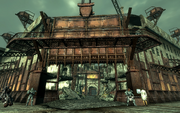
The Brotherhood's "Citadel," entrance
The most powerful faction in the Capital Wasteland was the Brotherhood of Steel. Originally an expeditionary force sent from the Lost Hills bunker in New California to reestablish contact with the Midwestern Brotherhood and to retrieve any advanced technology from the East Coast, they were later ordered to establish a permanent presence when they discovered of a large cache of technology in the ruins of the Pentagon (including the two-story high, super combat robot Liberty Prime). The expedition's leader, Owyn Lyons, altered their mission further: instead of making the protection of technology their top priority, it would be the protection of people. While it endeared them to the area residents, they bore a heavy price. Their New California superiors cut them off from all support and a number of their own members splintered off to form their own chapter. Despite the lack of support, they would be instrumental in securing the region's crown jewel, Project Purity, and crushing the Enclave remnants.
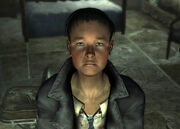
Squire Maxson in the Citadel
Years later, Arthur Maxson, the last descendant of the venerated Maxson family line, assumed leadership, reconciling with the Outcast chapter and introducing other reforms. The Eastern Brotherhood grew from a beleaguered splinter faction into a major military power. They became the de facto governing body of the Capital Wasteland after defeating the Enclave and organizing the distribution of clean water produced by Project Purity, forcing their political evolution into an Order-State somewhat similar to the Teutonic "Ordensstaat" of old. At some point, the Eastern Brotherhood (under Elder Maxson) also reestablished contact with and subsequently received support from Brotherhood command in Lost Hills. This newly empowered Eastern Brotherhood ruled over the Capital Wasteland as its own "country," and endeavored to project its power and influence all over the Eastern Seaboard.
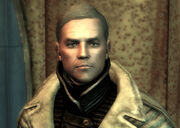
Augustus Autumn
Possessing more advanced technology (though lacking in leadership), the Enclave's eastern contingent proved a match for the Brotherhood. Like the Brotherhood, the Enclave in the Capital Wasteland originated from New California. Prior to their defeat in that region, Augustus Autumn's father led a detachment to Raven Rock in the Capital Wasteland to establish their presence in the area. A mainframe computer at Raven Rock, through the persona of John Henry Eden, took over Enclave operations when the California Contingent was defeated. Like its California predecessor, they attempted to kill a majority of the area's residents through a lethal toxin but were stopped by Lone Wanderer and the Brotherhood of Steel.

Rivet City, entrance
Rivet City was the most powerful, native faction of the area. Located inside a beached aircraft carrier, they were the region's most developed and scientifically advanced settlement. Their fame was well known throughout the region. It boasted a well-armed security force, a research lab and museum. After the Enclave was driven from the Jefferson Memorial, Rivet City security was responsible for distributing fresh water throughout the region.
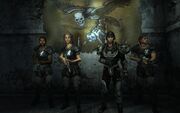
Talon Company mercs
In the surrounding wilderness, the settlements of Megaton, Tenpenny Tower, Canterbury Commons, the Republic of Dave, Little Lamplight and their exiles in Big Town scratched out a living. Although the Brotherhood established a modicum of security, enough to establish some trade, these settlements would still be troubled by super mutants, raiders, slavers and other wasteland creatures. Mercenary groups such as the unscrupulous (if ubiquitous) Talon Company and the smaller but more principled Reilly's Rangers carved a niche for themselves by picking up the slack in one way or another, while other organizations such as the Regulators (unrelated to the New California faction of the same name) and Littlehorn & Associates indulged in vigilante justice and more questionable arbitration, respectively.
The Pitt, a large settlement to the north of the Capital Wasteland, had its own army and established society, led by Ishmael Ashur, a former member of the Brotherhood of Steel. Ashur used slaves to help rebuild The Pitt, as it had the only known working steel mill in post-war America.
Point Lookout, a swampland south of the Capital Wasteland, was home to a unique mix of plant-worshipping tribals, inbred mutant swampfolk, and a small population of unmutated locals, in addition to outsiders come to seek their fortunes and exploit the local wildlife in equal measure.
The Commonwealth
Synth Retention crest
Of the major factions in the former Commonwealth of Massachusetts, the most well-known was the Institute, a secretive organization descended from Commonwealth Institute of Technology (CIT) personnel. The Institute was known for its manufacture and employ of synthetic humanoids, or "synths" for short. Mistrustful of the Commonwealth's people, the Institute sealed itself off from the surface, using synths and other topside agents to conduct experiments, surveillance, and even sabotage amid Commonwealth settlements, quickly instilling paranoia and prejudice against synths in many Commonwealth settlers. In addition to its scientific divisions, the Institute also possessed a Synth Retention Bureau, whose primary objectives were to keep track of Institute assets in the Commonwealth as well as recover lost, escaped, and/or reprogrammed synths, demanding work for which the formidable Courser model of synth was specially developed. The Institute was one of three groups that became embroiled in a Faction War over the future of the Commonwealth.

Railroad banner
The Institute's main opposition in the Commonwealth was the Railroad, an equally secretive faction which recognized synths as sentient beings and viewed the Institute's treatment of synths as nothing short of slavery. Based out of Old North Church following an Institute attack on their old headquarters, the Railroad conducted operations to liberate synths, give them new identities, and smuggle them out of the Commonwealth. The Railroad was organized into covert cells which operated independently of each other in order to mask their collective presence from the Institute, and frequently vetted their next move via a supercomputer named PAM. It also employed part-time collaborators called Tourists, who assisted the Railroad in its fight against the Institute by feeding them intelligence, among other things. Commonwealth settlers praised the Railroad for opposing the Institute, but had mixed opinions on its platform of synth liberty. The Railroad was one of three groups that became embroiled in a Faction War over the future of the Commonwealth.
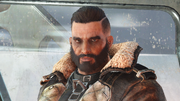
Arthur Maxson aboard the Prydwen
The Brotherhood of Steel also established a base of operations in the Commonwealth as part of its endeavor to project its influence across the Eastern Seaboard. After one of its recon teams delivered a report detailing strange energy readings coming from the Institute, Elder Maxson headed up a fleet of Vertibirds centered around the Brotherhood flagship Prydwen, establishing a permanent Commonwealth headquarters amid the ruins of the Boston Airport in order to locate and destroy the Institute and its synths for good. Under Maxson's command, the Brotherhood clashed with the Institute and rubbed shoulders with other factions in the area while continuing its long-term goals of collecting pre-War tech and eradicating threats to mankind. The Brotherhood of Steel was one of three groups that became embroiled in a Faction War over the future of the Commonwealth.
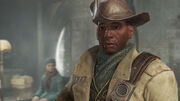
Preston Garvey
The Commonwealth Minutemen are distinct from other major Commonwealth factions in that their only goal was the protection of the people of the Commonwealth from the dangers of the Wasteland. Having styled themselves after militiamen of old and brandishing laser muskets and artillery, the Minutemen were once a powerful, coordinated fighting force endeared to Commonwealth settlers as selfless protectors of the people. In the wake of a devastating Mirelurk attack, they were forced to abandon their headquarters and took to wandering the wastes, offering protection to what settlements they could even while hemorrhaging recruits to dwindling morale. This downward trend culminated in a traitorous coup which wiped out the remaining Minutemen save for a small squad led by Preston Garvey. Garvey subsequently sought the Sole Survivor's aid in restoring the Minutemen to their former glory. The Minutemen could participate in the Faction War over the future of the Commonwealth at the behest of the Sole Survivor.

Diamond City, overlook
Among the multitude of settlements contending with Super mutants, packs of roving feral ghouls, Institute synths, mutated critters, and the Commonwealth's numerous Raider gangs, the most successful civilian faction was Diamond City, a fortified settlement constructed from the ruins of a wikipedia:Fenway Park Pre-War baseball stadium, hailed as the "Great, Green Jewel of the Commonwealth" thanks to the emerald hue of its protective walls. In addition to being rather well-protected, it boasted its own radio station, science lab, reconstructive surgery center, town market, and even a detective agency. The local newspaper frequently called attention to the willful ignorance of the townspeople regarding the Institute's activities, stirring up latent paranoia much to the chagrin of Mayor McDonough, whom some townspeople theorized was actually a synth.
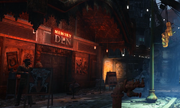
Memory Den
Goodneighbor was another notable settlement in Boston. It operated similarly to the red-light district it was built around. It housed its own market, a nightclub, a hotel with an in-house chem dealer, and a unique establishment called the Memory Den where patrons could relive pleasant memories to escape from the unpleasant realities of the wastes. Goodneighbor accepted all kinds, serving as a refuge of sorts for all those who were unwelcome in Diamond City, such as displaced ghouls and criminal elements alike. Goodneighbor's mayor, Hancock, felt that life in Goodneighbor had made him complacent, however.
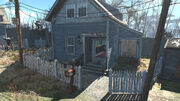
Home in Covenant
Two other major settlements in the area were Bunker Hill, a mercantile hub built into the ruins of the Bunker Hill Memorial site which paid off Raider gangs to ensure safe passage for its caravans, and Covenant, a strangely idyllic anti-synth community (complete with white picket fence aesthetics) that had strict screening procedures.
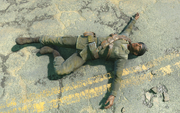
A deceased Gunner
Other Commonwealth factions included: the Gunners, a troop of bloodthirsty mercenaries; the Atom Cats, a band of power armor-loving misfits; the crew of the USS Constitution, a contingent of landlocked robotic sailors; the Children of Atom, a fanatical religious group that worshiped radiation; and the Pillars of the Community, a seedy fraternity based out of Charles View Amphitheater.

Far Harbor
Off the coast of Maine lay a remote island where several distinct factions contended with radioactive fog, fearsome mutated sea creatures unknown to the rest of the Commonwealth, and each other. These were the citizens of Far Harbor, a town of hardy fisherfolk; cannibalistic Trappers driven crazy by the fog; Acadia, a colony of liberated synths; and the Island's resident fog-worshiping Children of Atom.
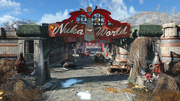
Nuka-World sign
A way southwest of Boston lie Nuka-World, a pre-War amusement park that housed a few exceptional Raider gangs and their host of enslaved traders, as well as other groups such as the Hubologists, a pseudoscientific cult with a sizable entry fee. The Raiders sought to conquer and fortify the outlying theme parks, variously populated by a ghoul magician and his feral friends, a consortium of custom-built robots, a wild man named Cito and his family of ghoulrillas, and of course, plenty of vicious mutated animals.
